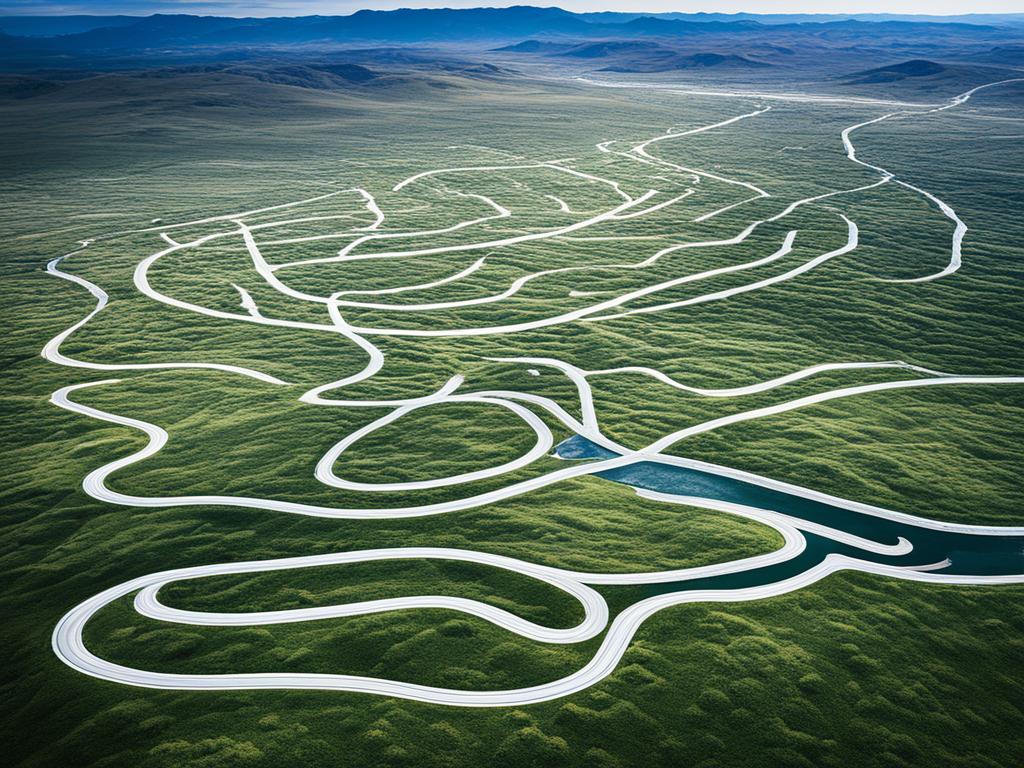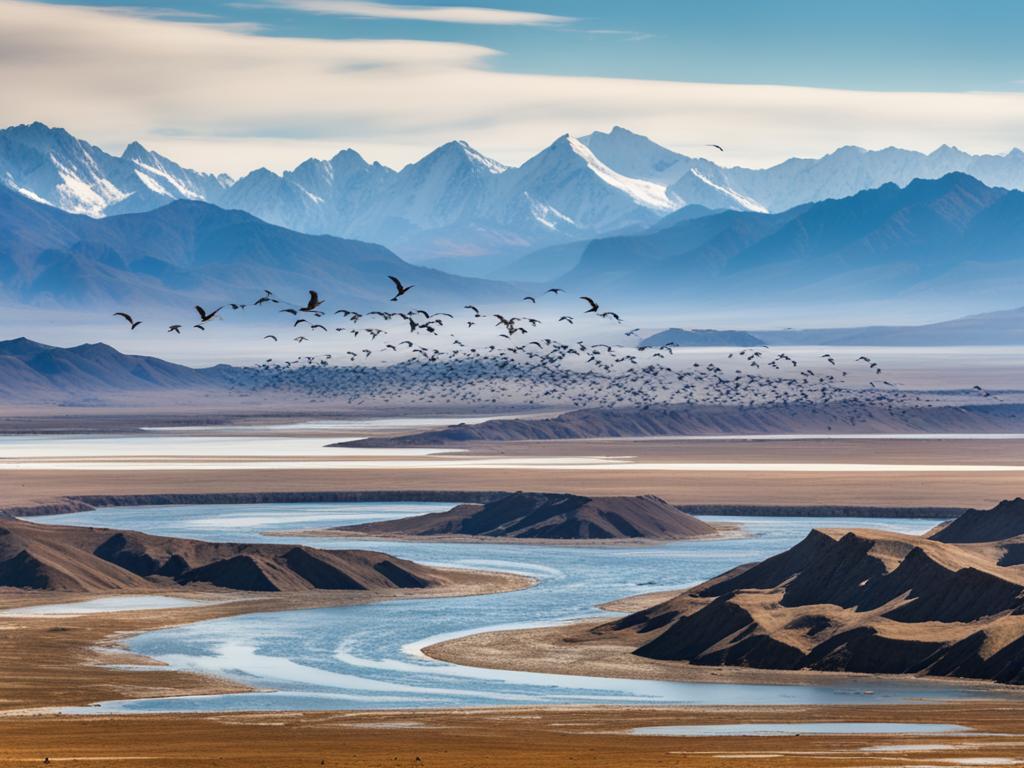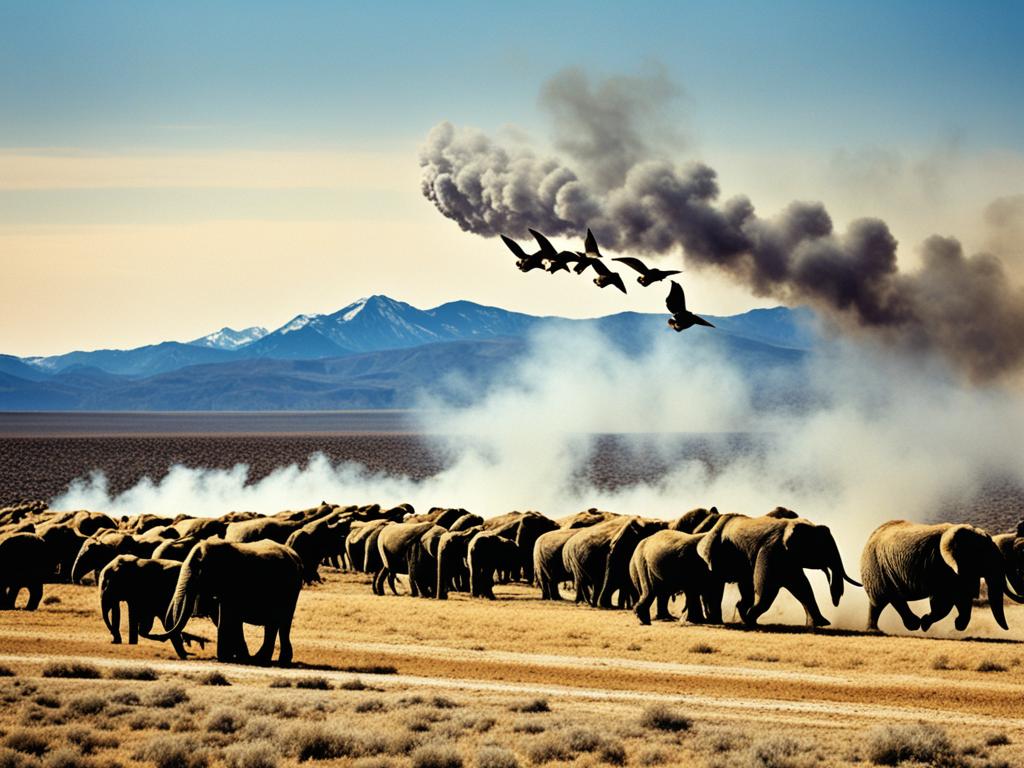Recently, we’ve seen how climate change affects wildlife migration. More than half of all species are finding new homes due to changing climates. Animals such as moose, bears, and elephants are moving northward or to higher places. They are searching for better living conditions.
In September 2023, the world hit record-high temperatures. July and August before it also had unprecedented heat. The World Economic Forum’s 2023 Global Risks Report talks about these issues. It says losing biodiversity and damaging ecosystems are big dangers for the next ten years. The University of Southern California has found animals like the pika changing where they migrate. This is because they need milder temperatures to survive.
Key Takeaways
- Climate change is driving a dramatic shift in wildlife migration patterns.
- Species like moose, bears, and elephants are migrating northward to find suitable habitats.
- Recent temperature records signify escalating global warming effects.
- The World Economic Forum highlights biodiversity loss and ecosystem collapse as major risks.
- University of Southern California research shows significant migration changes in species like the pika.
Introduction to Animal Migration and Climate Change
Animal migration paths are closely linked to seasonal environmental cues. These cues have helped many species with timing and finding their way. But now, climate change is shaking up these signals. This leads to big changes in how animals move and where they live.

Scientists stress how important predictable environmental cues are. They keep migratory animals and their homes in sync. But as the climate warms, timing for birds and the way mammals move is changing. Animals must adjust to new settings or struggle to survive.
Keeping migratory animals in tune with their environment is getting tough. Changes in their usual paths mean they might not find the resources they need. This shift forces animals into new areas. Here, they create new living patterns, which challenges age-old migration practices.
So, studying how animals move is more urgent than ever due to climate change. We must understand how changing environmental cues affect them. Our goal is to see how these shifts influence their movements. This helps protect these species for the future.
Climate-Driven Species Displacement
Climate change is making animals move to new places. It’s changing where they live and find food. Mammals and birds are really feeling these shifts.
Impacts on Mammals
For mammals, this means they need to find new homes. Caribou, for example, now migrate at different times. This change is because it’s warmer and there are more bugs.
Polar bears are having a tough time too. They’re struggling because there’s less sea ice for them to hunt on. Animals are facing new challenges, like finding food. This can upset the balance in nature.
Impacts on Birds
Birds are also getting hit hard by climate change. Their travel patterns are changing. This makes it hard for them to find food and safe places to nest.
They have to deal with new challenges or they might not survive. These problems show how climate change is a big threat to birds and their future.
Environmental Effects on Migratory Behavior
Climate change affects migratory species greatly, changing how they behave. It messes with their usual seasonal patterns. This causes changes in when and where they move.
Changes in Migration Timing
The environmental effects on migratory behavior show up clearly in how migration times change. For example, mule deer adjust their moving times to deal with these changes. But not all animals can adapt easily. Caribou face big shifts that mess with their survival rates.

Alterations in Migration Routes
Changes in migration paths are also a big deal due to climate change. The usual routes many species depend on aren’t reliable anymore. Birds, for example, have to work harder to find places to live. This means longer trips and using more energy, which can affect their health and ability to have babies.
These changes in migration timing and paths show that some animals can handle new environmental challenges better than others. While some adapt well, others find it hard, and this could upset the balance in nature.
| Species | Migration Timing Changes | Route Alterations |
|---|---|---|
| Mule Deer | Adapted to new seasonal signals | Minimal route changes |
| Caribou | Significant shifts observed | Major disruptions in traditional routes |
| Birds | Erratic timing adjustments | Increased journey lengths |
Global Warming Impact on Wildlife
Global warming is changing wildlife worldwide, with significant impacts. Through case studies, we learn how animals struggle with the heat. This includes changes in their habitats and food sources.

Case Studies of Affected Species
Elephants moving from Zimbabwe to Botswana show us how they adapt. They leave due to not enough space and water. Another study on the Chinook salmon shows how warm water raises their energy needs. These examples help us understand the big problems wildlife faces due to global warming.
Physiological Strain on Migratory Animals
Migrating animals face tough challenges because of the warmer climate. They need more energy to keep their body temperature right. Also, their breeding timing gets messed up, making life harder. For Chinook salmon, hot water is a big stress. This tells us how migrating animals are struggling. We need new ways to help wildlife survive in our changing world.
Habitat Shifts Due to Climate Change
Climate change is causing big changes for many species. They move to higher places and cooler areas to live. This happens because their usual homes are no longer good for them.
From Forests to Higher Elevations
In North America, many species are leaving forests for higher grounds. A study in 2011 found that wildlife and plants move up around 36 feet every ten years. This is mainly due to warmer temperatures and changes in their environments.
Migration to Cooler Regions
Species are also moving to cooler areas to cope with heat. When it gets hotter, they find new places with better weather to live. But, this can introduce new species that harm the local ecosystems, changing how animals interact.
The need to study and save our wildlife is more important than ever. We must understand how climate change affects life to protect biodiversity and the health of ecosystems.
Climate-Induced Range Alterations
Climates are changing, forcing animals and plants to find new homes. Because of warmer places, different rain, or season changes, they can’t stay. They move to areas where they can live better.
Now, species need to be tough to handle these changes. They move up mountains or closer to the poles to find similar homes.
These moves change ecology a lot. When animals and plants shift, they meet new friends or foes, fighting over space and food. It also makes us wonder how this will affect nature’s balance in the long run.
Not all creatures adjust well to change. Some do it quickly, while others struggle. This tells us we must work fast to help those in need through research and saving plans.
To wrap it up, it’s crucial to combat the negative effects of these shifts. Our planet’s many life forms and their homes depend on it.
Conservation Efforts and Future Outlook
Climate change poses a big challenge for migratory species. To help them survive, conserving their habitats is key. Projects led by the World Economic Forum’s Centre for Nature and Climate aim to fight climate change and protect biodiversity.
For a better future for species, we need a global effort towards sustainability. We must focus on actions that stop climate change and help nature. By doing so, we can ensure a future where nature and humans thrive together.
Reaching these objectives involves several steps. We need to fix natural habitats and make policies work well. We also must get communities involved in green practices. As people worldwide join hands, we can find lasting ways to protect life on Earth from climate change.


